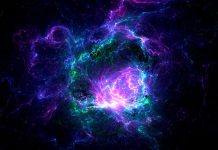
Astronomers have just uncovered what may be the most massive black hole ever detected in the universe—an astonishing 36 billion times the mass of our Sun.
This cosmic giant sits at the heart of a distant galaxy known as the Cosmic Horseshoe, located about 5 billion light-years from Earth.
The Cosmic Horseshoe gets its name from the dramatic shape created when its massive gravity bends the light of a background galaxy into a horseshoe-like ring, a phenomenon called gravitational lensing.
But what lies at the center of the orange-colored Horseshoe galaxy is even more fascinating—an ultramassive black hole that could change what we know about how black holes and galaxies grow together.
Most large galaxies, including our own Milky Way, have supermassive black holes at their centers.
In general, the bigger the galaxy, the bigger the black hole. While our Milky Way’s central black hole is about 4 million times the mass of the Sun, this newly measured black hole is nearly 10,000 times more massive.
What makes this discovery even more remarkable is how the team measured it.
Usually, black hole masses are estimated by looking at the bright material they swallow, such as dust and gas. But this method only works when black holes are actively feeding and glowing.
In this case, however, the black hole is “dormant”—not actively pulling in material—so its detection relied entirely on its enormous gravitational effects.
The research team, led by Ph.D. candidate Carlos Melo in Brazil and Professor Thomas Collett in the UK, used a combination of two powerful tools: gravitational lensing and stellar kinematics. Gravitational lensing allowed them to detect how the black hole bends light from a distant galaxy. Stellar kinematics, meanwhile, involved measuring how fast stars near the black hole are moving—close to 400 kilometers per second—due to its gravity. By combining these two methods, the scientists were able to confidently confirm the black hole’s presence and its massive size.
The discovery also sheds light on the galaxy itself. The Cosmic Horseshoe is a so-called fossil group galaxy, which means it has likely gobbled up all its neighboring galaxies over billions of years. As those galaxies merged, their central black holes probably merged too, creating the enormous black hole we see today.
This finding could help scientists better understand the link between galaxies and their central black holes. As galaxies grow, they feed matter to their black holes. Some of this matter shines brightly as a quasar—a powerful energy source that can heat and blow gas out of the galaxy, stopping new stars from forming.
Our own galaxy may face a similar fate. In about 4.5 billion years, the Milky Way and the Andromeda galaxy are expected to merge. This could cause our central black hole to flare up again as a quasar.
The research team hopes to use this new method with upcoming space telescope data, including from the European Space Agency’s Euclid mission, to discover more hidden giants like the Cosmic Horseshoe black hole and learn how black holes shape the universe.
Source: NASA.



